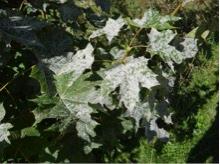Powdery Mildew
-
AboutPowdery mildew is a common disease on many types of plants and is prevalent in many areas of California. Infection occurs when fungus contacts a suitable host and environmental conditions are favorable. Infections spread as spores produced in these white patches move by wind and splashing rain to other locations on the plant or nearby plants. The fungus survives the winter attached to plant parts and plant debris such as fallen leaves. As weather warms in spring, the process begins again.
 Photo: Wikimedia Commons
Photo: Wikimedia Commons -
Category
-
Fungi
-
-
Signs/Symptoms
White powdery spots develop on both leaf surfaces and expand as the infection grows. Initial symptoms are small, circular, powdery, white spots which expand and eventually join as infections progress. Leaves turn yellow or brown and fall off, exposing the plant or fruit to sunburn. Leaves or shoots can twist or distort. Infected leaves generally die and drop from the plant earlier than healthy leaves. The fruiting parts of vegetables are usually not affected, but apples, grapes, and stone fruits can develop web like russet scars or corky areas.
-
Where
Serious problem on woody species such as rose, crape myrtle, and sycamore. May infect new or old foliage. Attacks new growth including buds, shoots, flowers, and leaves.
-
When
Moderate temperatures of 60° to 80°F and shady conditions. Spores and mycelium are sensitive to extreme heat and sunlight, and leaf temperatures above 95°F may kill the fungus. Moisture during the spring inhibits growth.
-
Prevent
As new shoots begin to develop on perennial plants, watch closely for signs of powdery mildew. Plant disease resistant varieties. Grow plants in sunny locations. Provide good air circulation by pruning excess foliage. Fertilize properly; too much nitrogen causes lush foliage and shade, providing conditions for fungal growth. Maintain good garden sanitation.
-
Manage
Overhead sprinkling may reduce the spread because it washes spores off the plant. Irrigate in mid-morning, so plants dry rapidly, reducing the likelihood of infections by other fungi. Horticultural oil or plant-based oils such as Neem oil may be effective. Never apply oils when temperatures are above 90°F or to water-stressed plants. Always consult the product label for any special precautions. Biological fungicides contain beneficial micro-organisms formulated into a product that destroys fungal pathogens when sprayed on the plant.
-
More Information

